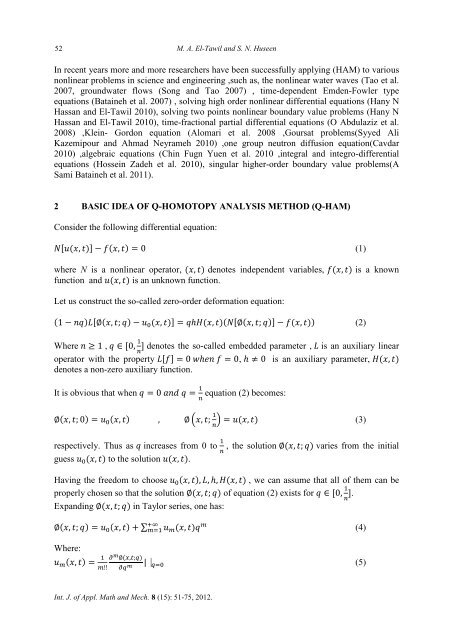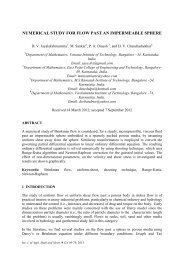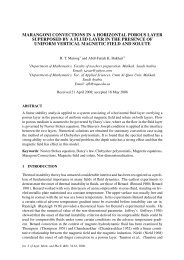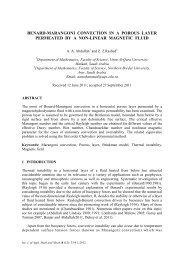THE Q-HOMOTOPY ANALYSIS METHOD (Q-HAM) - IJAMM
THE Q-HOMOTOPY ANALYSIS METHOD (Q-HAM) - IJAMM
THE Q-HOMOTOPY ANALYSIS METHOD (Q-HAM) - IJAMM
Create successful ePaper yourself
Turn your PDF publications into a flip-book with our unique Google optimized e-Paper software.
52<br />
Int. J. of Appl. Math and Mech. 8 (15): 51-75, 2012.<br />
M. A. El-Tawil and S. N. Huseen<br />
In recent years more and more researchers have been successfully applying (<strong>HAM</strong>) to various<br />
nonlinear problems in science and engineering ,such as, the nonlinear water waves (Tao et al.<br />
2007, groundwater flows (Song and Tao 2007) , time-dependent Emden-Fowler type<br />
equations (Bataineh et al. 2007) , solving high order nonlinear differential equations (Hany N<br />
Hassan and El-Tawil 2010), solving two points nonlinear boundary value problems (Hany N<br />
Hassan and El-Tawil 2010), time-fractional partial differential equations (O Abdulaziz et al.<br />
2008) ,Klein- Gordon equation (Alomari et al. 2008 ,Goursat problems(Syyed Ali<br />
Kazemipour and Ahmad Neyrameh 2010) ,one group neutron diffusion equation(Cavdar<br />
2010) ,algebraic equations (Chin Fugn Yuen et al. 2010 ,integral and integro-differential<br />
equations (Hossein Zadeh et al. 2010), singular higher-order boundary value problems(A<br />
Sami Bataineh et al. 2011).<br />
2 BASIC IDEA OF Q-<strong>HOMOTOPY</strong> <strong>ANALYSIS</strong> <strong>METHOD</strong> (Q-<strong>HAM</strong>)<br />
Consider the following differential equation:<br />
[ ] (1)<br />
where N is a nonlinear operator, denotes independent variables, is a known<br />
function and is an unknown function.<br />
Let us construct the so-called zero-order deformation equation:<br />
[ ] [ ] (2)<br />
Where , [ ] denotes the so-called embedded parameter , is an auxiliary linear<br />
operator with the property [ ] , is an auxiliary parameter,<br />
denotes a non-zero auxiliary function.<br />
It is obvious that when<br />
respectively. Thus as increases from 0 to<br />
guess to the solution .<br />
(<br />
equation (2) becomes:<br />
) (3)<br />
, the solution varies from the initial<br />
Having the freedom to choose , we can assume that all of them can be<br />
properly chosen so that the solution of equation (2) exists for [ ].<br />
Expanding in Taylor series, one has:<br />
Where:<br />
∑<br />
(4)<br />
(5)





